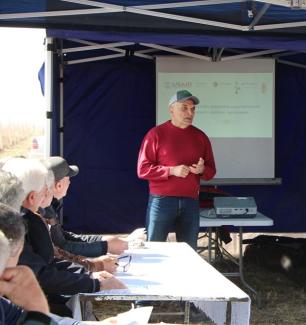A critical part of USAID’s work around the world is building the capacity of local organizations to drive continued change and improvement. In Armenia the Center for Agribusiness & Rural Development Foundation (CARD) has grown over the last 16 years from a fledgling organization unsure of its viability to a vital USAID partner and a financial and commercial success, with the capacity to transform Armenia’s agricultural systems.
CARD was founded in 2005 as the successor to United States Department of Agriculture (USDA) assistance programming in Armenia. Gagik Sardaryan, the Director of CARD, explains in a recent interview, “In 2003 or 2004 there was a workshop in Tsaghkadzor, bringing together people from agriculture universities, the private sector, from the U.S. Embassy and USAID. The task was to design what will happen after USDA leaves Armenia.” CARD was envisioned as a “one stop shop model” which emulated the USDA Marketing Assistance Program (MAP) and would provide services from “farmgate to marketplace.” These services included technical advice, training, equipment, access to finance, and marketing assistance.
It was not clear at the outset that CARD would survive as an organization. “For us it was a very stressful period. There was no sign what would happen. We were going to cut staff, maybe 70 percent or more. […] We were lucky that USAID picked up [its level of support for Armenia] and the foundation has operated under USAID-funded projects,” he says. CARD has been an implementing partner for several USAID/Armenia activities, including the Partnership for Rural Prosperity, Development of Private Extension Service System in Armenia, and Advanced Rural Development Initiative, and is currently implementing the Rural Economic Development-New Economic Opportunities (RED-NEO) project.
Through these activities USAID supported the creation of several Farm Service Centers (FSCs), which act as hubs for a range of agricultural extension services. The FSCs are operated on a franchise basis, and CARD links them to world-class agricultural inputs, equipment, and knowledge. “This FSC model wasn’t tested yet when USAID entered,” explains Sardaryan. But the model has proven highly effective, with FSCs typically achieving profitability in the first month, “The World Bank and government looked at this model and found it very attractive and they started to build the same FSCs in other regions.” In Armenia’s Syunik region, nearly half of all farmers have benefited from the FSC located in Meghri, whether through equipment rental, cold-food storage, produce drying racks, training and access to resources and more. Today CARD has a network of 20 FSCs, and there are two more planned for construction.
CARD has also become highly skilled at demonstrating the value of advanced technologies and techniques to Armenia’s farmers. Sardaryan shared an example from CARD’s work in the dairy sector. In 2017, CARD organized a seminar in a village near Yerevan that collectively had approximately 5,000 cows, but was still using antiquated systems and manual labor to produce milk. The seminar focused on disease control, breeding, milking, “smart farm” models. “But we said that [this seminar] was not enough for the farmers to understand how they can change,” explains Sardaryan, “So we did a demo project [with a farmer] in the mountains.” With the installation of a milking shed and mechanized milking, the farmer found that the quality and quantity of the milk increased, and the milk processor buying the milk paid 5-10 percent more because of the improved quality. “Now, many farmers in the mountains have this milking system.”
A critical component to CARD’s success is the organization’s efforts to always take a “systems approach” when working with a community. This approach creates linkages and commercial relationships between similar producers and between different parts of the value chain. For example, when RED-NEO helps a farmer purchase a fruit dryer, that producer will then work with other surrounding fruit producers so they can also make use of the new equipment. As Sardaryan discusses, this approach, “gives a multiplier effect to development.” CARD is able to link together business, donors, and the government to address the gaps in the industry.
Today CARD has achieved financial sustainability and is positively impacting Armenia’s agriculture sector without the need for donor funding. Under the CARD Foundation umbrella are six “spin off” organizations, independent entities, working in different agriculture sectors: livestock; equipment and technology; food processing and marketing; greenhouse and open field production, credit, and equipment leasing. The CARD Foundation’s board recently approved its budget, funded through dividends from these “daughter” organizations. “It is a very realistic budget,” says Sardaryan, “We feel very comfortable as a foundation, it will continue to work as a market driven organization.”
[[nid:414071]]
[[nid:414076]]

CARD
